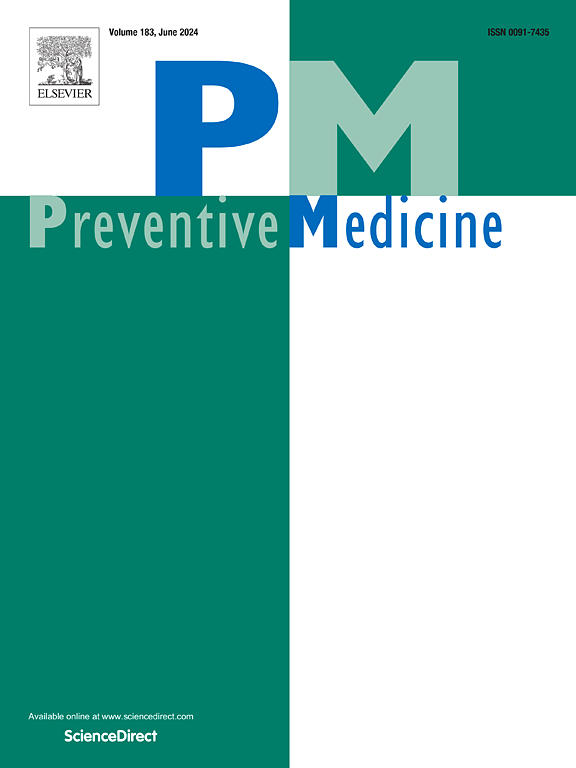“周末战士”体力活动模式与勃起功能障碍的关系:巴西的一项大型横断面研究。
IF 3.2
2区 医学
Q1 MEDICINE, GENERAL & INTERNAL
引用次数: 0
摘要
目的:探讨周末战士体力活动模式与勃起功能障碍之间的关系,包括按年龄组和肥胖分层的分析。方法:对2008-2022年在巴西一家医院筛查的15655名年龄在bb0 - 40岁的男性的数据进行分析。使用国际身体活动问卷对身体活动进行评估。参与者被分为三种体育活动模式:不符合建议(定义为:结果:勃起功能障碍患病率为22.4% %。周末战士模式最初与勃起功能障碍有关,但这种联系在调整后失去了意义。在调整后的模型中,有规律的运动模式仍然与勃起功能障碍的可能性降低相关(OR: 0.90;95 %置信区间:0.82—-0.99)。在成年人中,这种关联持续存在(OR: 0.90;95 %置信区间:0.82—-0.99)。在非肥胖者中,有规律的运动模式也与较低的勃起功能障碍可能性相关(OR: 0.88;95 %CI: 0.79-0.98),而在肥胖个体中,这种关联仅在未调整的模型中具有显著性。结论:周末战士模式在调整后的模型中没有显示出显著性,而定期运动模式与勃起功能障碍的可能性较低有关,特别是在成年人和非肥胖个体中。本文章由计算机程序翻译,如有差异,请以英文原文为准。
Association of ‘weekend warrior’ physical activity pattern and erectile dysfunction: A large cross-sectional study in Brazil
Objective
To examine the association between the weekend warrior physical activity pattern and erectile dysfunction, including analyses stratified by age group and obesity.
Methods
Data from 15,655 men aged >40 screened at a Brazilian hospital (2008–2022) were analyzed. Physical activity was assessed using the International Physical Activity Questionnaire. Participants were grouped into three physical activity patterns: not meeting recommendations (defined as <150 min/week of moderate-to-vigorous physical activity), weekend warrior (defined as ≥150 min/week on one or two days), and regularly active (defined as ≥150 min/week on three or more days). Erectile dysfunction was assessed using the International Index of Erectile Function score (<22 indicating erectile dysfunction). Logistic regression tested the association between erectile dysfunction and physical activity patterns using unadjusted and adjusted models (adjusted for age, lifestyle and clinical conditions).
Results
Erectile dysfunction prevalence was 22.4 %. The weekend warrior pattern was initially associated with erectile dysfunction, but this association lost significance after adjustment. The regularly active pattern remained associated with lower erectile dysfunction likelihood in adjusted model (OR: 0.90; 95 %CI: 0.82–0.99). Among adults, this association persisted (OR: 0.90; 95 %CI: 0.82–0.99). In non-obese individuals, the regularly active pattern was also associated with lower erectile dysfunction likelihood (OR: 0.88; 95 %CI: 0.79–0.98), while in obese individuals, the association was significant only in the unadjusted model.
Conclusion
The weekend warrior pattern did not show significance in adjusted models, while the regularly active pattern is associated with a lower likelihood of erectile dysfunction, particularly among adults and non-obese individuals.
求助全文
通过发布文献求助,成功后即可免费获取论文全文。
去求助
来源期刊

Preventive medicine
医学-公共卫生、环境卫生与职业卫生
CiteScore
7.70
自引率
3.90%
发文量
0
审稿时长
42 days
期刊介绍:
Founded in 1972 by Ernst Wynder, Preventive Medicine is an international scholarly journal that provides prompt publication of original articles on the science and practice of disease prevention, health promotion, and public health policymaking. Preventive Medicine aims to reward innovation. It will favor insightful observational studies, thoughtful explorations of health data, unsuspected new angles for existing hypotheses, robust randomized controlled trials, and impartial systematic reviews. Preventive Medicine''s ultimate goal is to publish research that will have an impact on the work of practitioners of disease prevention and health promotion, as well as of related disciplines.
 求助内容:
求助内容: 应助结果提醒方式:
应助结果提醒方式:


